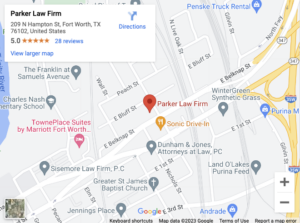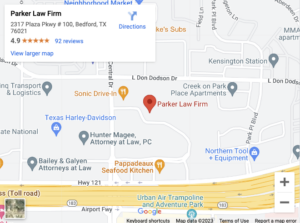Who Are the Plaintiffs and Defendants in Personal Injury Cases?
Many personal injury lawsuits filed in Texas are settled through private settlement negotiations or mediation. However, a small number of cases result in personal injury lawsuits. The primary parties to a personal injury lawsuit in Bedford are the plaintiff and the defendant.
Who Is the Plaintiff in a Texas Personal Injury Lawsuit?
The plaintiff is the party who files the lawsuit. In a personal injury case, the plaintiff is the injured party.
For example, the plaintiff in a car accident case could be:
- The driver of one of the vehicles
- The passenger in any of the vehicles involved in the car crash
- A pedestrian or bicyclist hit by a car
- Family members or a deceased person’s estate in a wrongful death action
A personal injury lawsuit begins with filing a complaint in a Texas civil court. The complaint and a summons are served on the defendants in the lawsuit.
Who Is the Defendant in a Texas Personal Injury Lawsuit?
A defendant is the person being sued in a lawsuit. In a personal injury case, the defendant is the party alleged to have caused the plaintiff’s injury.
Examples of defendants in personal injury cases include, but are not limited to:
- Property owners, tenants, business owners, landlords, and other parties in control of a property (premises liability claims)
- A motorist, trucking company, passenger, bicyclist, or pedestrian (motor vehicle accidents)
- Dog owners, tenants, and property owners (dog bite cases)
- Government agencies (public transportation injuries, slip and fall accidents, and other injuries on public property)
- Designers, manufacturers, distributors, and other parties responsible for product being on the market (product liability claims)
- Property owners, contractors, and subcontractors (construction accidents)
- Doctors, nurses, hospitals, medical facilities, and other medical providers (medical malpractice claims)
- The owners and operators of nursing homes and staff members (nursing home abuse cases)
Any party who contributed to the cause of the plaintiff’s injury could be responsible for their economic and non-economic damages. It is important to name all responsible parties as defendants in a personal injury lawsuit to increase the source of compensation for damages.
Other Parties to a Personal Injury Lawsuit
There are cases where another party might be brought into the lawsuit or might file pleadings in a lawsuit.
Other parties that might be involved in your personal injury claim include:
- Third-party defendant (impleader) – This party is someone a defendant brings into the lawsuit to shift some or all of the blame for the plaintiff’s injury to that party
- Joinder – A party who joins the lawsuit as a plaintiff because they allege they have the right to damages because of the same incident
- Interpleader – A party who alleges they have a claim arising from the same or similar circumstances
- Intervention – Parties who have a statutory right to enter a lawsuit
Third-party defendants are the most common type of parties added to a personal injury lawsuit. If another party joins your lawsuit, it can impact your case.
What Are the Steps in a Personal Injury Lawsuit?
Each lawsuit is unique. Lawsuits have their own timeline. However, many of the steps in a personal injury lawsuit are similar in most cases.
The steps in a typical personal injury lawsuit include:
- Filing a complaint and serving it on the defendant
- The defendant responds to the complaint
- The parties engage in discovery to gather additional evidence and information about the case
- The parties can engage in settlement negotiations, mediation, and other alternative dispute resolution
- Pre-trial motions are filed and heard by the court regarding matters of law
- The trial involves the plaintiff and defendant presenting their evidence in court
- The jury deliberates privately to decide whether to rule for the plaintiff or the defendant
The parties may appeal the verdict if they believe they have legal grounds to overturn the trial results. An appeal could take several years to complete.
What Does a Plaintiff Need to Prove for a Personal Injury Lawsuit in Bedford, TX?
Most personal injury cases are based on negligence claims. However, some cases might involve strict liability or intentional torts.
For a negligence claim, the plaintiff must have sufficient evidence to prove by a preponderance of the evidence that:
- The defendant had a legal duty of care they owed the plaintiff
- There was a breach of duty by the defendant because of their actions or omissions
- The defendant’s breach of duty was the cause of the plaintiff’s injuries
- The plaintiff sustained injuries and incurred damages
Proving causation, fault, and liability for a personal injury case can be challenging. Working with an experienced Bedford personal injury lawyer gives you a better chance of recovering fair compensation for your claim.
Contact the Bedford Personal Injury Lawyers at Parker Law Firm Injury Lawyers for Help Today
For more information, please contact an experienced personal injury lawyer at Parker Law Firm Injury Lawyers to schedule a free initial consultation today. We have convenient locations in Fort Worth and Bedford, Texas.
Parker Law Firm Injury Lawyers – Fort Worth
209 N Hampton St,
Fort Worth, TX 76102
(817) 510-9400
Parker Law Firm Injury Lawyers – Bedford
2317 Plaza Pkwy #100,
Bedford, TX 76021
(817) 503-9200


